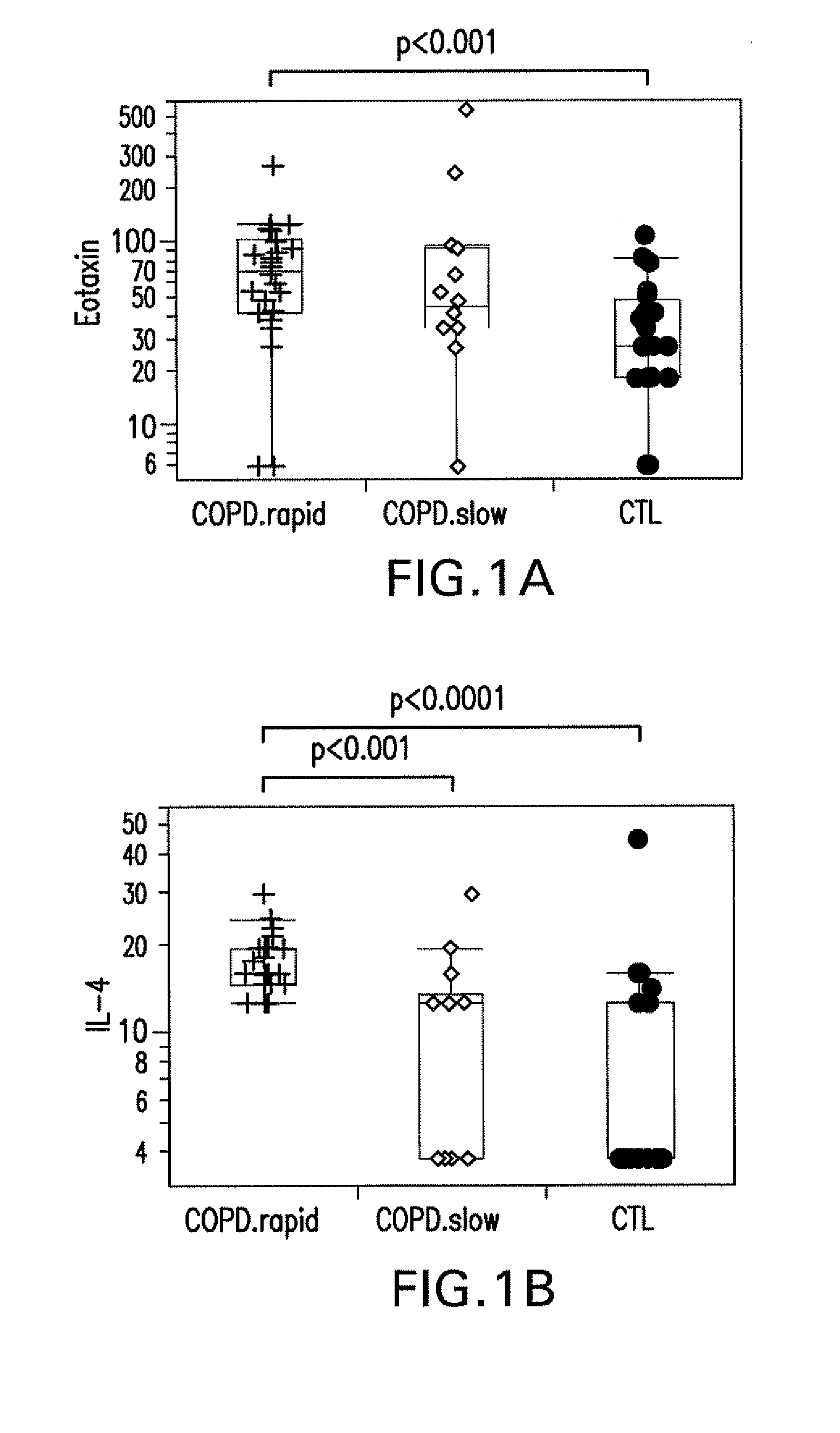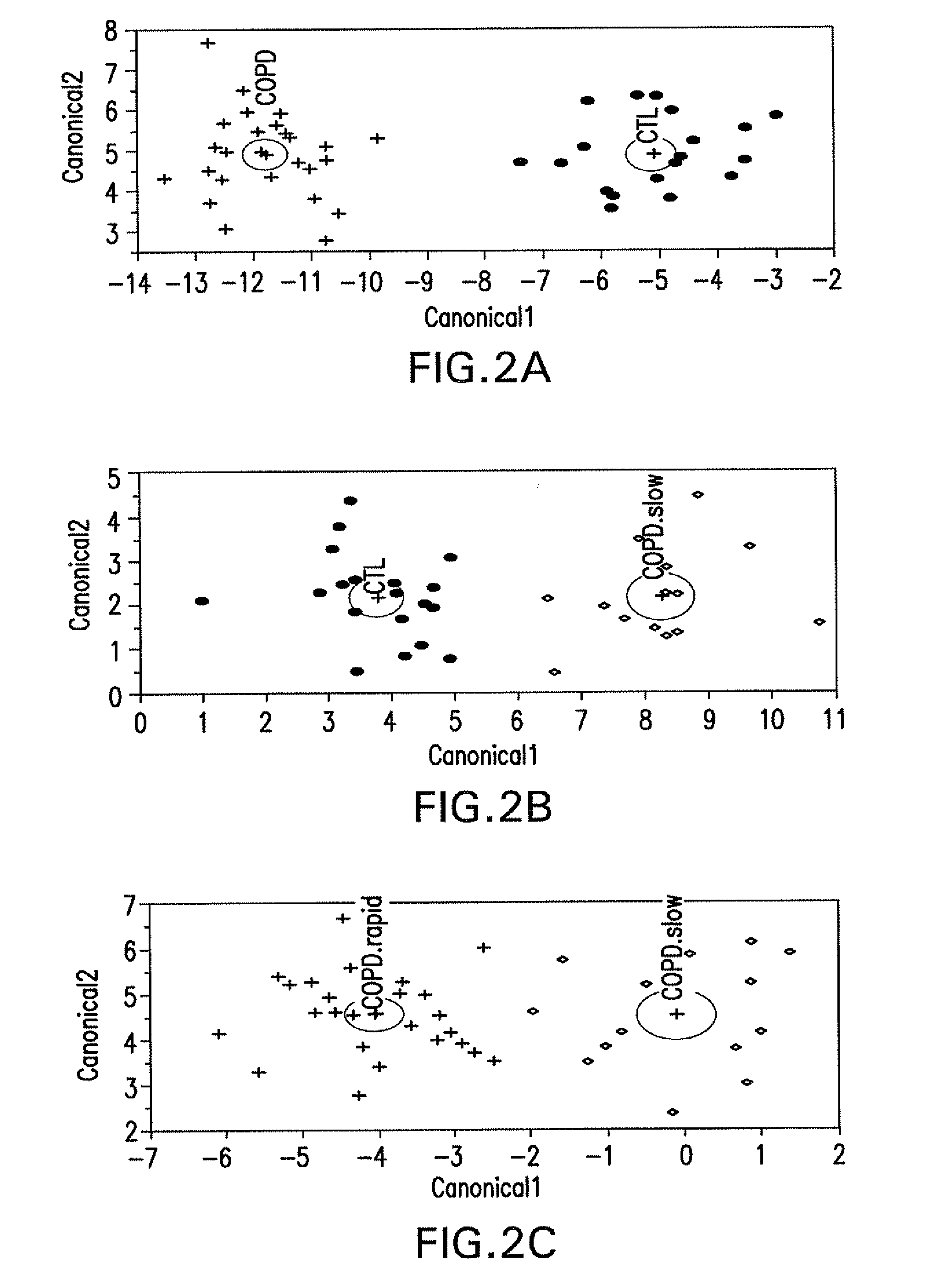COPD biomarker signatures
a biomarker and signature technology, applied in the field of rapid detection and accurate diagnosis of chronic obstructive pulmonary disease, can solve the problems of dyspnea, accelerated limitation of physical performance, increased pulmonary function decline, etc., and achieve the effect of rapid detection and positive diagnosis of copd
- Summary
- Abstract
- Description
- Claims
- Application Information
AI Technical Summary
Benefits of technology
Problems solved by technology
Method used
Image
Examples
example 1
Collection of Study Subjects
[0091]Blood was collected in citrate buffer at the end of a 15-year longitudinal lung function study from 40 COPD patients and 20 healthy controls. COPD patients and healthy controls were either current or ex-smokers. The COPD patients were initially recruited in 1987-88 as part of the NIH funded National Lung Health Study, a 5-year longitudinal study of pulmonary function (Owens, 1991, Am. J. Med. 91:37 S-40S). Patients recruited were 35-59 years old current smokers with FEV1 ranging between 50% and 90% of predicted, an FEV1 / forced vital capacity (FVC) less than 0.7 and presenting the characteristic respiratory symptoms of COPD. Spirometry was performed every year during the Lung Health Study. For the COPD patients evaluated in this study, additional spirometry was done at various intervals during the following 10 years at the University of Utah. Based on the 15-years longitudinal information on lung function, COPD patients were distributed in two distin...
example 2
Analysis of Plasma Markers
[0092]Frozen plasma samples were sent to Rules-Based Medicine, Inc. (Austin, Tex.) for analysis of markers in their proprietary Human Antigen MAP platform. Frozen plasma samples were thawed at room temperature, vortexed, spun at 13,000×g for 5 minutes for clarification, and 40 uL was removed for markers analysis into a master microtiter plate. Using automated pipetting, an aliquot of each sample was introduced into one of the capture microsphere multiplexes of the Human Antigen MAP. These mixtures of sample and capture microspheres were thoroughly mixed and incubated at room temperature for 1 hour. Multiplexed cocktails of biotinylated, reporter antibodies for each multiplex were then added robotically and, after thorough mixing, were incubated for an additional hour at room temperature. Multiplexes were developed using an excess of streptavidin-phycoerythrin solution which was thoroughly mixed into each multiplex and incubated for 1 hour at room temperatur...
example 3
[0093]Univariate analysis of individual markers—The significance of each marker between COPD rapid decliners versus healthy controls, COPD slow decliners versus healthy controls, and COPD rapid versus COPD slow decliners was assessed using Wilcoxon rank sum test. Exact p-values were determined using the Shift algorithm (Streitberg and Rohmel (1986) Exact Distribution for Permutations and Rank Test: An Introduction to Some Recently Published Algorithms. Statistical Software Newsletter. 12:10-17). In addition, the strength of the significance of each marker was further assessed using the more stringent false discovery rate. False Positive Rate (FPR), estimated by p-value, is the proportion of false positives among all the markers that in reality did not change. False Discovery Rate (FDR), estimated by q-value, is the proportion of significant changes that are false positives. The q-value for each marker was derived using the method proposed by Benjamini & Hockberg (Benjam...
PUM
 Login to View More
Login to View More Abstract
Description
Claims
Application Information
 Login to View More
Login to View More - R&D
- Intellectual Property
- Life Sciences
- Materials
- Tech Scout
- Unparalleled Data Quality
- Higher Quality Content
- 60% Fewer Hallucinations
Browse by: Latest US Patents, China's latest patents, Technical Efficacy Thesaurus, Application Domain, Technology Topic, Popular Technical Reports.
© 2025 PatSnap. All rights reserved.Legal|Privacy policy|Modern Slavery Act Transparency Statement|Sitemap|About US| Contact US: help@patsnap.com



